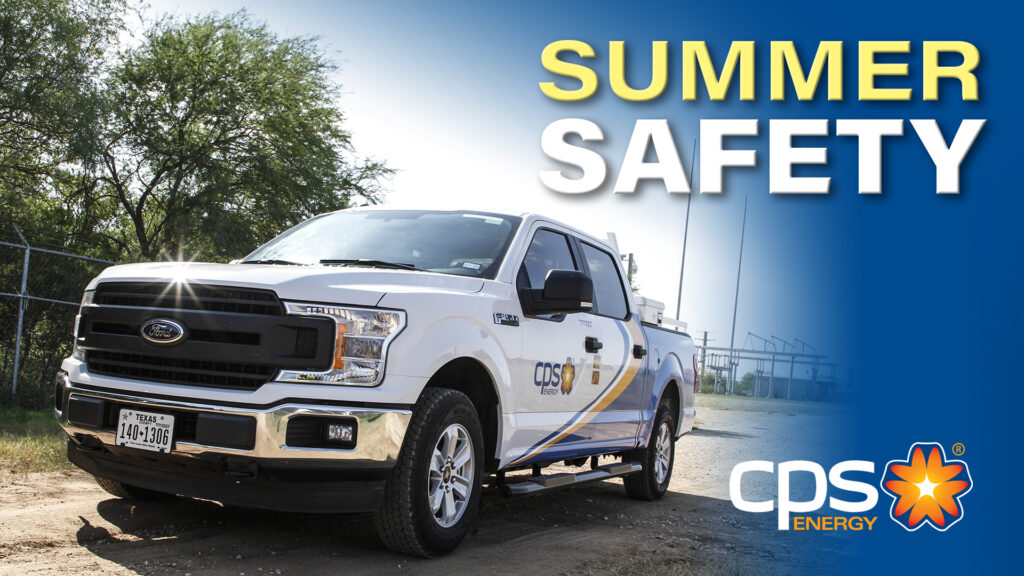Hit the road with these vehicle safety tips
Summer’s here – and don’t we know it with this triple-digit weather – and that means it’s time for a staycation or hitting the road to destinations far and wide. According to Travelpulse.com, around 80 percent of folks expected to vacation this summer are planning road trips. But before you hit the road, safety should always be a top priority. Making sure your vehicle receives maintenance before you take off can make a huge difference in having a peaceful trip with your passengers, but most importantly in keeping you and your family safe.
Jaime Garcia, Interim Senior Manager of Fleet Operations at CPS Energy, is no stranger to vehicle maintenance. He’s been with the fleet department for 22 years. With the record-breaking heat we’re seeing, he offers a basic, but sometimes forgotten, tip on how to cool off your vehicle quicker.
“When you get in your car after it’s been sitting for a while, all of that heat is trapped inside your vehicle,” Jaime says. “Rolling your windows down for a few minutes while you let the heat escape, will help your air conditioner not have to work as hard and will help the interior of your car cool down faster.”
Running the AC hard also decreases your fuel efficiency. And these days, every drop of gas counts. Gas prices have skyrocketed, especially after the turmoil taking place in the Ukraine. Drivers are looking for any way to save at the pump and Jaime has some good tips to maximize gas mileage with things to do before you take off on a trip.
Gas savings (and safety) tip #1: Maintain tire pressure.
“Make sure your tires are properly inflated. You’ll burn more gas with underinflated tires than you would with properly inflated tires, plus it’s unsafe to drive a vehicle like that for too long, especially in this heat, because the tires start wearing out and they could bust,” Jaime says. “Always check the inflation of your tires.”
One way to check that pressure is by purchasing a pressure gauge. You can find pressure gauges at your local Wal-Mart or auto store. You can also visit places such as Discount Tire that provide inflation stations for you to check the pressure. Some places will even check your tires for free. So how do you know what your pressure should be? “Always check on the door jamb of your car. There, it will tell you what the proper inflation of your tires should be. Always go with what your manufacturer recommends for your vehicle,” Jaime says.
Gas savings tip #2: Watch where you fill up.
Filling up is painful for everyone’s pocket right now so where you decide to fill up can save money. Gas stations right off main highways are typically a lot more expensive due to the convenience of their location. Monitoring your gas and planning ahead to avoid those convenient locations can help you save at the pump.
Gas savings tip #3: Don’t idle.
Avoid idling your car as idling uses more gas. “Idling your car is actually worse for your engine,” Jaime says. “When you drive on the road your engine produces carbon. As long as you’re driving, that carbon is blowing out of your exhaust system. However, when you’re idling, that carbon and soot builds up inside your motor and that’s not good for your motor.” While your car is designed to idle briefly, like at stoplights, it is not designed to be a place to cool off or sit in for prolonged periods of time. Being aware of how much time you spend idling can help you save, plus it’s good for the environment.
Before you hit the road, making sure your vehicle is properly maintained is crucial. A few things to look for are making sure you’re not past due for an oil change and checking to make sure the fluids in your car are topped off. Check belts and hoses for any cracks and take note of how old your tires are. The older they are, the faster they heat up which can cause them to bust.
A few other things to pay attention to include making sure your seatbelts are in tact and that all of your lights are working. Check to make sure wiper blades are not old. Just because Texas has seen minimal rain, does not mean that the destination you are heading to won’t have any. Making sure you have working ones will help you to be prepared. Finally, make sure your brakes are in good condition. “If the pedal feels lower to you than normal or if you’re hearing a squeaky noise when pushing on the brake, that’s a sign that they should be replaced,” Jaime says.
You’ve heard the term “better safe than sorry” and before heading out on a road trip, or for everyday driving, a basic safety kit that can live in your car can prove to be extremely beneficial. In true dad form, Jaime assembled one recently for his daughter who is about to go to college. Some things he recommends keeping in your car in the event of an emergency include:
- Set of jumper cables
- Flashlight
- Road hazard triangles
- Water
- First aid kit
- Tire pressure gauge
- A map (in the event your phone dies)
- A jack
- Basic tools
A little preparation goes a long way when hitting the road. Plan your route, watch out for the multitude of highway constructions projects underway across our nation, and have the number to Triple A or another roadside service on hand. “Plan your route before you take off that way in case something happens to you, you are more prepared,” Jaime says. “Knowledge is the best tool you can have when you go on a road trip.”



